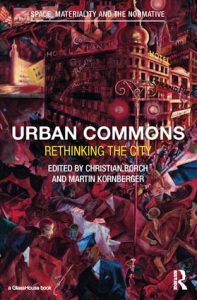Borch, Christian, and Martin Kornberger (eds). Urban Commons: Rethinking the City. Abington, Oxon: Routledge, Taylor & Francis Group, 2015.
The collection of essays edited by Christian Borch and Martin Kornberger offers a series of case studies on urban commons and the communities around them. This book is about sharing, negotiation, conflict, co-operation and all other relations that happen in urban life. These issues are treated from a variety of perspective and approaches. However, they have in common a mainly empirical approach and an interest in social rules, institutions, and relations. For instance, we find the process by which a landfill in Nicaragua was turned into a mean of living for the least well-off who acted as rubbish collectors (Producing, appropriating and recreating the myth of the commons by Zapata and Zapata), the conflicts on who defines the right to live in Danish housing societies (Communities and the commons: Open access and community ownership of the urban commons by Maja Hoger Bruun), or how a train station became a shared space for myriads of different activities despite the efforts by public authorities to limit them to the ‘socially acceptable’ (Sharing an atmosphere: spaces in Urban Commons by Orvar Löfgren).

Source: Taylor & Francis
As well, they share a sceptic vision on the transformative power of the commons: on their own, they will not save the world. For example, the work by Leif Jerram “The False Promise of the Urban Commons” describes how London and Berlin as a whole became commons for the LGTB community. Yet, this did not largely change the situation of discrimination of this collective (and those who profited more from it may have been owners of bars and other entertainment businesses). However, they do recognise the potential of the commons as spaces of provision for citizens, particularly those who cannot access to products offered through the market. A good example is the chapter by Zapata and Zapata, which shows how the collective action of appropriating the landfill and the rejects of other parts of society triggered a movement of defence against the privatisation of recycling services..
I found this book a clear and insightful collection of points of view over commons, those who create and use them, and the processes by which they are appropriated in our cities. The book avoids both the economic determinism of “The Tragedy of the Commons” and the optimism bordering on wishful thinking of some post-Marxist authors which give the commons quasi-magical properties of societal change. In this volume, commons are collectively appropriated or created, profit is taken from them, suffer privatisation attempts, are argued over… and are simultaneously as alternative to and embedded in market systems. Collectively, the introduction and the seven essays extend the definition of a commons beyond that of the ‘rival, non-excludable’ into resources that exist always in relation to a community, who sometimes creates them and sometimes conssumes them. According to this volume, then, many resources would be ‘commons in potency’ and become such by means of collective action. However, I found that this reworking of the definition was too often left implicit. If something was missing from this work is the critical dialogue with the classics of the topic. As it both drew from and expanded away from Ostrom, Hardin, and the like, more engagement with these titles would have been useful in order to see more clearly how is the field of the commons evolving and what can still be learnt from the cornerstones of the field. As well, I missed in the choice of cases: out of seven cases, five are located in Europe, one in North America, and one in the Global South (Nicaragua).
All in all, this is a valuable collection of pieces that offer ample insights on how commoning works at an urban level. It presents a variety of case studies, which, if mostly located in similar contexts, they present a wide range of social phenomena linked to the urban commons and offer new views and reflect on potentials and shortcomings of these urban alternatives.